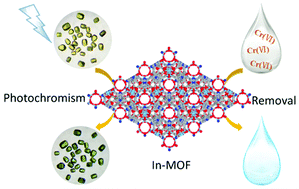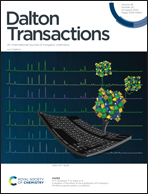A zwitterionic ligand-based water-stable metal–organic framework showing photochromic and Cr(vi) removal properties†
Abstract
As one of the highly crystalline porous materials, metal–organic frameworks (MOFs) have drawn immense attention due to their diverse structures and a wide variety of applications. In this study, [In3(ipbp)2(μ2-OH)(μ2-O)3] (1) that has a three-dimensional framework, including two types of cages with cuboctahedra and trigonal antiprism configurations, has been successfully synthesized based on the zwitterionic ligand 1-(3,5-dicarboxyphenyl)-4,4′-bipyridinium bromide (H2(ipbp)Br). Strikingly, a relatively rare trapeziform metal layer consisting of In3+, μ2-OH, μ2-O, carboxyl, and nitrogen from the ligand appears in the structure of 1. Benefitting from the formation of the ipbp radicals under UV light irradiation, compound 1 exhibits photochromic property that can transform the color from yellow to green. Moreover, it possesses commendable Cr(VI) removal capacity with the maximum adsorption amount of 74.4 mg·g−1 due to the surface electrostatic interaction between the crystal surface and Cr(VI) in the aqueous system. This work will promote the design of functional MOFs that show potential applications in UV light detection and removal of oxyanions.



 Please wait while we load your content...
Please wait while we load your content...